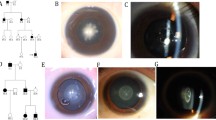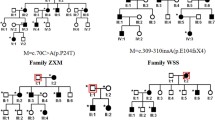Abstract
A substrain of mice originating from the CF#1 strain (an outbred colony) reared at Osaka Prefecture University (CF#1/lr mice) develops cataracts beginning at 4 weeks of age. Affected mice were fully viable and fertile and developed cataracts by 14 weeks of age. Histologically, CF#1/lr mice showed vacuolation of the lens cortex, swollen lens fibers, lens rupture and nuclear extrusion. To elucidate the mode of inheritance, we analyzed heterozygous mutant hybrids generated from CF#1/lr mice and wild-type BALB/c mice. None of the heterozygous mutants were affected, and the ratio of affected to unaffected mice was 1:3 among the offspring of the heterozygous mutants. For the initial genome-wide screening and further mapping, we used affected progeny of CF#1/lr × (CF#1/lr × BALB/c) mice. We concluded that the cataracts in CF#1/lr mice are inherited through an autosomal recessive mutation and that the mutant gene is located on mouse chromosome 3 between D3Mit79 and D3Mit216. In this region, we identified 8 genes associated with ocular disease. All 8 genes were sequenced and a novel point mutation (1 bp insertion of cytosine) in exon 7 of the Bcar3 gene was identified. This mutation produced a premature stop codon and a truncated protein. In conclusion, we have identified the first spontaneous mutation in the Bcar3 gene associated with lens extrusion cataracts. This novel cataract model may provide further knowledge of the molecular biology of cataractogenesis and the function of the BCAR3 protein.






Similar content being viewed by others
References
Agrawal N, Nayak DP, Haripriya A, Bhuwania P (2015) Phacoemulsification with toric IOL implantation in Alport syndrome with anterior lenticonus having spontaneously ruptured anterior capsule. Eur J Ophthalmol 25:e78–e80
Bassnett S, Mataic D (1997) Chromatin degradation in differentiating fiber cells of the eye lens. J Cell Biol 137:37–49
Cai D, Iyer A, Felekkis KN, Near RI, Luo Z, Chernoff J, Albanese C, Pestell RG, Lerner A (2003) AND-34/BCAR3, a GDP exchange factor whose overexpression confers antiestrogen resistance, activates Rac, PAK1, and the cyclin D1 promoter. Cancer Res 63:6802–6808
Gotoh T, Cai D, Tian X, Feig LA, Lerner A (2000) p130Cas regulates the activity of AND-34, a novel Ral, Rap1, and R-Ras guanine nucleotide exchange factor. J Biol Chem 275:30118–30123
Graw J (2004) Congenital hereditary cataracts. Int J Dev Biol 48:1031–1044
Graw J (2009) Mouse models of cataract. J Genet 88:469–486
Graw J, Neuhäuser-Klaus A, Löster J, Favor J (2002) A 6-bp deletion in the Crygc gene leading to a nuclear and radial cataract in the mouse. Invest Ophthalmol Vis Sci 43:236–240
Gray W, Sponsel WE, Scribbick FW, Stern AR, Weiss CE, Groth SL, Walker JD (2011) Numerical modeling of paintball impact ocular trauma: identification of progressive injury mechanisms. Invest Ophthalmol Vis Sci 52:7506–7513
Grove M, Demyanenko G, Echarri A, Zipfel PA, Quiroz ME, Rodriguiz RM, Playford M, Martensen SA, Robinson MR, Wetsel WC, Maness PF, Pendergast AM (2004) ABI2-deficient mice exhibit defective cell migration, aberrant dendritic spine morphogenesis, and deficits in learning and memory. Mol Cell Biol 24:10905–10922
Kang M, Cho JW, Kim JK, Kim E, Kim JY, Cho KH, Song CW, Yoon SK (2008) Fine localization of a new cataract locus, Kec, on mouse chromosome 14 and exclusion of candidate genes as the gene that causes cataract in the Kec mouse. BMB Rep 41:651–656
Kohale K, Ingle A, Kelkar A, Parab P (2004) Dense cataract and microphthalmia–new spontaneous mutation in BALB/c mice. Comp Med 54:275–279
Kondo T, Nagai H, Morioka H, Kusakabe KT, Okada T (2010) Novel cataract mouse model using ddY strain: hereditary and histological characteristics. J Vet Med Sci 72:203–209
Kondo T, Ishiga-Hashimoto N, Nagai H, Takeshita A, Mino M, Morioka H, Kusakabe KT, Okada T (2011) An increase in apoptosis and reduction in αB-crystallin expression levels in the lens underlie the cataractogenesis of Morioka cataract (MCT) mice. Med Mol Morphol 44:221–227
Kondo T, Ishiga-Hashimoto N, Nagai H, Takeshita A, Mino M, Morioka H, Kusakabe KT, Okada T (2014a) Expression of transforming growth factor β and fibroblast growth factor 2 in the lens epithelium of Morioka cataract mice. Congenit Anom (Kyoto) 54:104–109
Kondo T, Nagai H, Kawashima T, Taniguchi Y, Koyabu N, Takeshita A, Kusakabe KT, Okada T (2014b) Hereditary and histologic characteristics of the CF1/b cac mouse cataract model. Comp Med 64:360–368
Liu Y, Zhang X, Luo L, Wu M, Zeng R, Cheng G, Hu B, Liu B, Liang JJ, Shang F (2006) A novel alphaB-crystallin mutation associated with autosomal dominant congenital lamellar cataract. Invest Ophthalmol Vis Sci 47:1069–1075
Mace PD, Wallez Y, Dobaczewska MK, Lee JJ, Robinson H, Pasquale EB, Riedl SJ (2011) NSP-Cas protein structures reveal a promiscuous interaction module in cell signaling. Nat Struct Mol Biol 18:1381–1387
Maeda YY, Funata N, Takahama S, Sugata Y, Yonekawa H (2001) Two interactive genes responsible for a new inherited cataract (RCT) in the mouse. Mamm Genome 12:278–283
Makkinje A, Vanden Borre P, Near RI, Patel PS, Lerner A (2012) Breast cancer anti-estrogen resistance 3 (BCAR3) protein augments binding of the c-Src SH3 domain to Crk-associated substrate (p130cas). J Biol Chem 287:27703–27714
McAvoy JW, Chamberlain CG, de Iongh RU, Hales AM, Lovicu FJ (1999) Lens development. Eye (Lond) 13(Pt 3b):425–437
Narita M, Wang Y, Kita A, Omi N, Yamada Y, Hiai H (2002) Genetic analysis of Nakano Cataract and its modifier genes in mice. Exp Eye Res 75:745–751
Near RI, Smith RS, Toselli PA, Freddo TF, Bloom AB, Vanden Borre P, Seldin DC, Lerner A (2009) Loss of AND-34/BCAR3 expression in mice results in rupture of the adult lens. Mol Vis 15:685–699
Okamura T, Miyoshi I, Takahashi K, Mototani Y, Ishigaki S, Kon Y, Kasai N (2003) Bilateral congenital cataracts result from a gain-of-function mutation in the gene for aquaporin-0 in mice. Genomics 81:361–368
Quinlan RA (2015) Drug discovery. A new dawn for cataracts. Science 350:636–637
Schrecengost RS, Riggins RB, Thomas KS, Guerrero MS, Bouton AH (2007) Breast cancer antiestrogen resistance-3 expression regulates breast cancer cell migration through promotion of p130Cas membrane localization and membrane ruffling. Cancer Res 67:6174–6182
Singh DP, Guru SC, Kikuchi T, Abe T, Shinohara T (1995) Autoantibodies against beta-crystallins induce lens epithelial cell damage and cataract formation in mice. J Immunol 155:993–999
Smith RS, Sundberg JP, Linder CC (1997) Mouse mutations as models for studying cataracts. Pathobiology 65:146–154
Song CW, Okumoto M, Mori N, Yamate J, Sakuma S, Kim JS, Han SS, Hilgers J, Esaki K (1997) A new hereditary cataract mouse with lens rupture. Lab Anim 31:248–253
Sun G, Cheng SY, Chen M, Lim CJ, Pallen CJ (2012) Protein tyrosine phosphatase α phosphotyrosyl-789 binds BCAR3 to position Cas for activation at integrin-mediated focal adhesions. Mol Cell Biol 32:3776–3789
Teramoto Y, Uga S, Matsushima Y, Shimizu K, Morita T, Shirakawa S (2000) Morphological study on rupture of posterior capsule in RLC mouse lens. Graefes Arch Clin Exp Ophthalmol 238:970–978
Vanden Borre P, Near RI, Makkinje A, Mostoslavsky G, Lerner A (2011) BCAR3/AND-34 can signal independent of complex formation with CAS family members or the presence of p130Cas. Cell Signal 23:1030–1040
Wallez Y, Riedl SJ, Pasquale EB (2014) Association of the breast cancer antiestrogen resistance protein 1 (BCAR1) and BCAR3 scaffolding proteins in cell signaling and antiestrogen resistance. J Biol Chem 289:10431–10444
Acknowledgments
This work was supported in part by JSPS KAKENHI, Grant Number 24500496.
Author information
Authors and Affiliations
Corresponding author
Rights and permissions
About this article
Cite this article
Kondo, T., Nakamori, T., Nagai, H. et al. A novel spontaneous mutation of BCAR3 results in extrusion cataracts in CF#1 mouse strain. Mamm Genome 27, 451–459 (2016). https://doi.org/10.1007/s00335-016-9653-8
Received:
Accepted:
Published:
Issue Date:
DOI: https://doi.org/10.1007/s00335-016-9653-8




